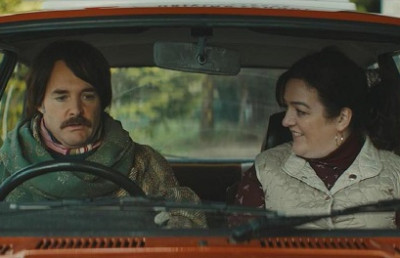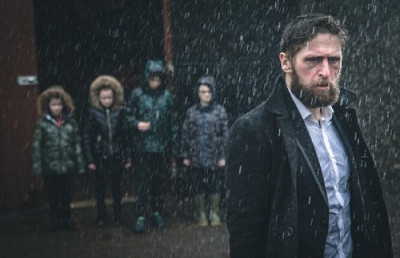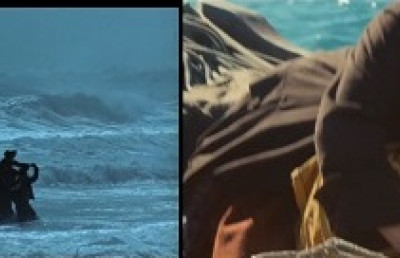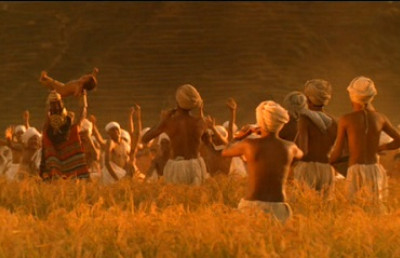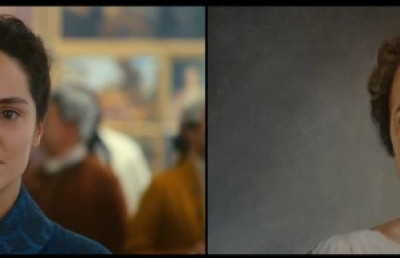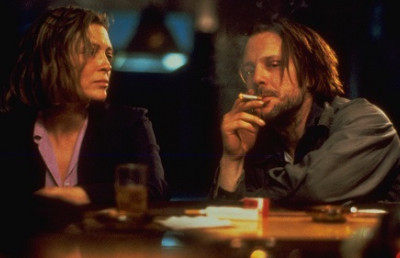The Fantastic Worlds of Lorcan Finnegan
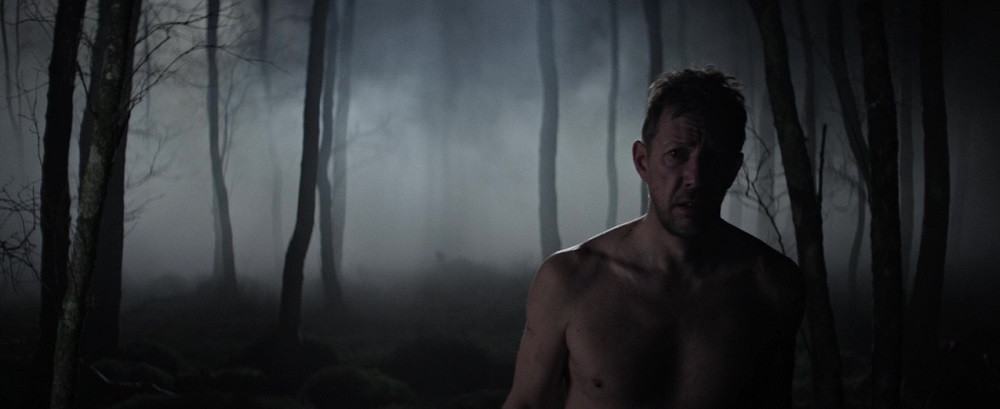
Without Name (photo source, Global Digital Releasing)
Filmmaker Lorcan Finnegan is leading the recent wave of Irish horror cinema (The Hallow, Grabbers, The Hole in the Ground, Bring Out the Fear, The Glenarma Tapes, Caveat, Unwelcome, Shrooms, You Are Not My Mother, Boys From County Hell) having directed three feature films and one short film that comfortably fit into the genre of the fantastic, with formal and thematic overtones that can be followed across the four films. These four films are, the short film Foxes (2011), his debut feature Without Name (2016), Vivarium (2019), and Nocebo (aka The Curse, 2022).
For my money his debut film Without Name is his strongest film, largely on the tightness of its premise, which sees a largely insecure early middle-aged academic Eric (Alan McKenna) slowly lose touch with reality as he succumbs to internal psychological issues (bad marriage, infidelity, career uncertainty) exasperated by environmental isolation of his research/work situation. The film is by far Finnegan’s most formally daring –not uncommon in a director’s debut film– in its jagged and associational editing, liberal use of flicker effects (rapid fire montage) and frequent reliance on abstraction. In a brief opening breakfast scene with Eric, his wife Margaret (Olga Wherly) and teen son Justin (Brandon Maher) the sterile mise en scene and lack of communication promptly establishes an unwell family. Eric is hired by a big land development company to survey a large patch of forest land the company has acquired, a job which they both know is far too expansive for one person but which he is hired for because of his “discretion” (i.e. willingness to play by corporate rules). Eric is soon joined by a young, attractive PhD student Olivia (Niamh Algar) who will function as his research assistant on the project. Unsurprisingly, Eric is having an affair with Olivia, which complicates matters where both family and work are concerned.
The only other character of note is Gus (James Browne), a late twenties, early thirty-something drifter who lives off the grid and befriends Eric and Olivia. It is interesting to see Gus as a version of Eric if he had taken a different path in his life. As written, Gus is seen by Eric simply as a threat for Olivia’s attention and to his conventional life choices.
Right from the start, Finnegan treats the woods as a magical place that can be at once inviting, at other times threatening. The importance of landscape is established in the opening scene which sees Eric surveying a rock quarry. It opens on a close-up of Eric, looking unusually pensive, then cuts to a long shot that establishes the space –Eric, his surveying equipment, his jeep– then in a slow, smooth movement zooms out to an extreme long shot of Eric overwhelmed by his greyish granite environment (suggesting the sterility of his family life has followed him into his work life). In a subtle gesture I only noticed on a repeat viewing, near the end of the zoom shot the open trunk door of his jeep inexplicably closes on its own, a gesture which introduces the fantastic in the everyday.
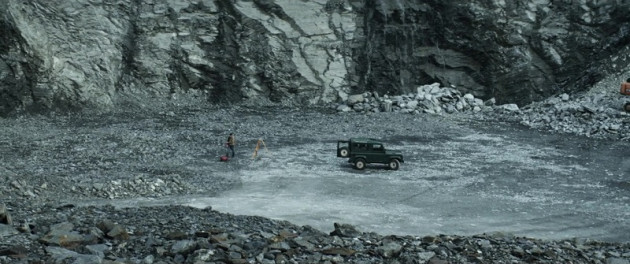
Without Name (photo source Global Digital Releasing)
The visual approach to the woods is always varied, changing in tone, color, atmosphere from one scene to the next. The first shot of the woods soon after he arrives in the area sees the image quiver as if the reality of the forest is subject to its own laws of physics. The few locals we see seem to fear the woods or see in it a place of mystery tied to folklore, Irish Faeries and inexplicable magic. In fact, Without Name can comfortably fit into the sub-genre of folk horror, a form of horror recently brought into critical limelight by Kier-La Janisse’s outstanding documentary, Woodlands Dark and Days Bewitched: A History of Folk Horror. Eric begins to lose track of why he is there and begins reading a hand-written notebook titled “Knowledge of Trees” left behind by the previous occupant Devoy. Whether due to the isolation, the shrooms he consumes with Gus and Olivia, or the herbal concoctions he makes based on recipes from Devoy’s hand-written notebook, or a likely combination of all three, Eric begins to lose touch with reality. Or is Eric, a la The Shining, being possessed by the spirit of the previous occupant of the cabin, Devoy (Brendan Conroy), who went mad while researching trees in these same forests? Devoy appears to Eric as an ominous silhouetted nude figure in the woods, peering at him through the trees and bushes, a shot formation we will see again in Finnegan’s later film, Nocebo. In a possible nod to Apocalypse Now Eric confuses the sight and sound of a moth fluttering around a lightbulb with sounds of a helicopter surveying above the forest (with the scenes intercutting between Eric in the cabin and Eric in the forest at night). The reference to Coppola’s film seems apt given the affinity both films have to the source story of Joseph Conrad’s Heart of Darkness, which may be the signature template for stories featuring people (in these cases both a man) driven mad in isolated jungles or forests.In a harrowing final scene in the forest Eric is stalked and nearly strangled to death by a seriously intimidating nude Devoy, which concludes not with Eric’s death but with a spellbinding hallucinogenic montage of blinding high contrast flicker effect images of the forest extreme close-ups of eyes, and shots of a distraught looking Devoy in his institutional bed, the visuals accompanied by a pulsating metronomic score. At its end Eric is found lying nude in the forest by a search party of his wife, son, lover Olivia and Gus. In the film’s coda, a mentally destroyed Eric is brought by wheelchair to the same mental hospital as Devoy, suggesting he has joined Devoy as another victim of the forest. Without Name remains my favorite of Finnegan’s films, marked by an emotional intensity generated by a remarkable fusion of form and content. [1]
Without Name (along with Vivarium and to a lesser extent Nocebo) has ties with Finnegan’s earlier short film Foxes, as both films pit a person overwhelmed by an encounter with nature. In Foxes a married photographer with a failing business, Ellen (Marie Ruane), becomes obsessed with a pack of foxes who visit her and her husband’s home at night. She begins to follow them into the nearby woods, taking photographs of them which have no apparent value for her business. Her behaviour and physical appearance begins to change after her encounter with the foxes, even sparking their dormant sex life when she initiates feral sex with her shocked husband. Ellen’s night forays get more frequent and she eventually goes missing. In the final scene the now distraught husband is alarmed by the sound of foxes rummaging through the garbage bins. When he tries to scare the foxes away he is startled by one fox in particular which stares at him with familiar eyes and yells out a primal scream directed at him. Has Ellen transformed into a fox? The cookie-cutter architecture of the neighborhood Ellen lives in, with every identical home lined in a symmetrical order and bathed in the same dull beige palette, looks ahead to symmetrical madness of the huis clos housing complex in Vivarium. The inspiration for the setting of Foxes (and by extension Vivarium) comes from a real place, as Finnegan explains in an interview:
“The location is a real ‘ghost estate’. There were about 100 houses in the development but only about 5 were occupied. So many people in Ireland were conned into believing that they had to ‘get on the property ladder’. House prices were soaring and the government was giving grants to builders to build huge developments in the middle of nowhere. People were buying off plans, confident that they would double their money within a few years. When everything crashed the builders pulled out and left hundreds of developments half finished. They litter the country like graveyards. The few unlucky people who bought in these ghost estates can’t sell up, they can’t borrow to move and they still have to pay back the massive loan they took out to buy the house that is now worth very little. They are trapped. So I wanted the place to feel like purgatory, a strange suburban limbo.” (MarBelle, Director’s Notes)

Foxes (photo source, Lorcan Finnegan)
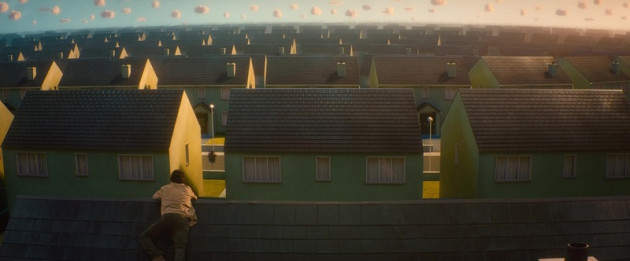
Vivarium (photo source Lionsgate Films)
My suspected ties between Foxes and Finnegan’s Vivarium were confirmed in the same interview when the interviewer asked Finnegan “Are there still plans for a psychological horror feature based in a Foxes-type world?” Finnegan replied:
“Yes! We have written a feature script and will be sending it to a few production companies next week. It is called VIVARIUM. It is about a young couple who follow a strange estate agent into a new development to look at a house. The development is brand new but completely devoid of life. They attempt to leave but soon find that they can’t find their way out of the maze of houses. Their car runs out of petrol and their phones die. A couple of days later a baby arrives in a box. That’s all I can tell you for now, but needless to say, it gets progressively worse for them.”
Finnegan's second film Vivarium is a social satire with science-fiction underpinnings but subtle and open ended in terms of its final meaning. It plays like an extended Twilight Zone or Black Mirror episode. The credit scene is nature at its cruelest, a cuckoo bird tossing out a newborn from its nest, later found by a school girl who cannot accept nature's cruelties. The person consoling the girl is her teacher, Gemma, played by Imogen Poots. And the man who ends up on a ladder nursing the tree is her boyfriend Tom (Jesse Eisenberg). That these characters are introduced this way is telling, in a script that is never without import at every moment.
Tom and Gemma are in the market for a new house and become tempted by a strange sales agent named Martin (Jonathan Aris) who they meet in a real estate showcase store. The agent drives them to a potential home in a new community called Yonder and shows them in, but then disappears, leaving them to exit the labyrinthian neighborhood themselves. Here and in the select overhead shots and establishing shots of the identically manicured cookie cutter streets and perfectly shaped clouds adorning the baby blue sky we see the influence of Dutch graphic artist and painter MC Escher (1898-1972) and his paintings of "infinity". They drive every which way but always arrive back at point A, apartment number 9. Their car eventually runs out of gas, leaving them no choice but to return to their comfortable though arid living quarters. They scale the roof of their house for a broader perspective but only see an infinity of sameness. They follow the sun from backyard to backyard but return to square one. Boxes of provisions appear serendipitously at their house. And one morning a box appears with a baby, which Gemma (tellingly) brings into the house. They have inadvertently been shaped into the 'perfect' nuclear family.
The film’s title refers to a space that houses animals or plants that are studied, which tells us all we need to know about their situation. Gemma and Tom are like proverbial lab rats, but who is studying them? The baby dropped at their doorstep ages out of human growth proportion, reaching age 8 in two months. As a child their ‘son’ is played by Senan Jennings and then by Eanna Hardwicke as a young adult. The child is a tabula rasa copying what it sees, a master imitator who alternates voice and sounds as required. The being maintains the baby habit of crying when desiring something, and annoyingly yells at the top of its lungs until a bowl of cereal is served. It is constantly in need of company and attention, to the point of utter frustration for the ‘new’ parents. The only thing it seems to desire beyond THEM is to sit in front of the TV and watch abstract images of black and white lines and static. As things settle, Gemma falls into the role of reluctant mother/teacher/guardian, although retaining her mantra, "I am not your mother", whenever the boy refers to her by that. Tom, who is a landscaper by profession, becomes obsessed with digging a hole in their front yard after seeing the fakeness of the ground under the grass. He hears something a few feet deep which convinces him to keep digging, until he comes across human remains (which foreshadows their own demise).
With nothing to live for Tom works himself to death. In an unnerving scene filmed in a dystopian reddish tint, the ‘son’ receives a box which contains a body bag for the disposal of Tom. The transparent vacuum sealed bag allows the face to be visible as air is sucked out constructing around Tom’s lifeless body, while his crying wife observes this surreal event. The son tosses the body bag into the pit, a gesture which is part of a long cycle. Gemma sees the son lift the sidewalk like a trapdoor and slip into a subterranean world, where she follows and discovers an Escherean loop of other 'couples' living the same life of trapped specimens. Gemma herself dies and ends up in the pit.
As viewer’s all that is left for us to ask is, “who is controlling this experiment?” The only clear clue we get from the Boy is in an earlier scene. When the boy returns after an absence Gemma asks him where he went and he tells her he went to meet someone, but is not allowed to say who. Gemma deceives him into imitating the person he met and the boy contorts his face and neck to a grotesque form and emits inhuman sounds. From this we deduce that he was in the presence of a non-human being, an alien, and assume that this whole scenario is a lab set up by an alien species to study humans.
The film ends with the grown son returning to the original showcase store in the city. He replaces the now aged 'Martin', puts him into a body bag and sends him down a chute behind a file drawer, assuming his role as the next salesman. A couple enters the store, the cycle about to start once again. Vivarium constructs a surreal fantasy world of suffocating perfection but leaves the ultimate meaning of things open for the viewer to mull over.
Lorcan Finnegan’s most recent film Nocebo (aka The Curse, 2022) is a horror film with a layer political subtext (a sweatshop in the Philippines servicing a children’s fashion designer label) that adds to what is essentially a supernatural revenge film. Although the revenge angle only becomes evident near the end of what also fits into the recent trend of nanny exploitation horror, or as critic Richard Shrieb said of Nocebo, “like a horror version of Mary Poppins (1964)”. The same year saw a similar themed film, Nanny (2022, Nikyatu Jusu), a template which has its roots in Ousmene Sembene’s excellent debut film Black Girl, which deals with a young African woman hired to work for a middle class Parisian couple and whose confrontation with ‘first world’ racism and intense cultural isolation leads to a tragic suicide.
Nocebo stars Eva Green stars as Christine, a fashion designer for a kid’s designer label named Tykie, married to financial strategist Felix (Mark Strong), with a young daughter Roberta (nicknamed Bobs, as played by Billie Gadson). In the opening scene Christine leaves a fashion shoot to take a phone call in a back room where she is mysteriously confronted by a flea infested black dog, whose shakes causes a tick to attach itself onto Christine’s neck. We later infer that the phone call she received was news of a tragic fire at the company’s Philippine sweatshop, an important event in the revenge story angle we will see in full in a flashback). The narrative moves ahead 8 months, with Christine suffering neurological problems from the tick bite. Unable to cope with work and family, a young Filipina woman magically announces herself at their door telling her “she is there to help her”, calmly insisting that Christine had hired her as a live-in Nanny. This is the first of many “memory lapses” Christine experiences, as she accepts the stranger’s unproven claim. The nanny is a woman named Diana (wonderfully played by Filipina actress Chai Fonacier) and she slowly infiltrates herself into the family, setting aside her luggage full of home-grown natural remedies she ritualistically manipulates, a shrine to her (we will later learn) dead daughter and a mysterious robotic like tick that she keeps in a tiny match box to unleash when needed. While Diana’s methods seem to help Christine’s body ailments, Felix and Roberta are more skeptical of Diana’s intentions. Diana conspires to control the family, spiking their food with unknown spices and seeds, stealing Christine’s medications, getting into Christine’s head and when Felix becomes too suspicious, using the flight of a bird to precipitate a fall which will hospitalize Felix.
What saves Nocebo from feeling like an exploitative Western gaze on non-western witchery is that Garret Shanley’s script spends considerable time developing Diana’s character by including frequent, well-timed flashbacks to Diana’s life in her rural village hometown, and the city of Cebu, going back to the story she tells Christine of how she inherited her magical powers from an elderly Ongo, which is a Philippine witch-like healer and practitioner of black magic, able to control animals, shapeshift, and transfer from body to body. The transference of powers occurs if someone is in the presence of the Ongo as she dies, which was the case with a young Diana as the Ongo transferred her spirit in the form of a duckling, from her mouth into Diana’s mouth.
In a shot which recalls several shots from Finnegan’s debut film, Without Name, a young Diana collects plants and herbs in the forest and sees from afar the spirit of the previous Ongo. Which foreshadows the last shot of the film. Diana completes her mission by committing suicide in Roberta’s presence so she can transfer her powers into the body of Christine’s daughter. In a shot that mirrors the young Diana collecting herbs we see Roberta doing the same, and seeing the spirit of Diana far off in the woods.
The depiction of the woods and forest area as a magical place looks back to Finnegan’s Without Name, a film which is set almost entirely in and around an eerie yet beautiful forest. At several narratively relevant points Finnegan cuts between the London set present and Diana’s past, like a clever match cut from Diana keeping Roberta out of school to walk with her to Diana walking with her daughter. We get a sensitive, playful scene where a young Diana first meets and dances with her future husband erHat a street festival. A painful scene where mercenaries are paid by a Western mining company to clear out a village from their homes so the land can be developed by the mining company. And the most potent and political flashback, which fully explains the revenge motif, is when we see Diana working at the sweatshop that produces clothes for the Tykie fast fashion designer label. (Supernatural revenge stories tied to sweatshops and Western fast fashion trends recalls Elza Kephart’s 2020 horror satire Slaxx). Diana hides her daughter under her work table because she has nowhere to keep her while she works. In a surprising twist, in one of these flashbacks we see Christine visiting the shop and instructing the foreman to increase production and keep the only door in the factory locked so workers can’t steal property. This demand indirectly leads to the death of Diana’s daughter, who burns in the fire as Diana is out getting her thirsty daughter coconut water.
As this is a Filipino-Irish co-production all these flashbacks were filmed in the Philippines, which adds to the authenticity of the story. Diana’s revenge is literal, as she forces Christine to work tirelessly at a sewing machine while somehow causing the room to become engulfed in the same flames as the sweatshop. This moment where the impossible occurs feels too contrived and stretches the credulity of the nature of Diana’s powers. If, as Felix suggests, Christine’s illness and by extension her visions are psychosomatic, then how can this fire be real? Similar moments occur where we assume what we are seeing is happening in Christine’s mind, like Christine’s comeback photo shoot which Diana sabotages by using Roberta’s xylophone in a ritual that causes Christine to imagine horrifying sights that precipitate a nervous breakdown which destroys the photo shoot.
Although the film benefits from the authenticity of Filipino actress Chai Fonacier’s excellent performance, the on-location flashbacks and the use of Filipino folkloric elements, the end result still feels like a case of all these trappings serving the supernatural revenge story. Although credit should be given to the film’s effort to raise awareness about exploitative Western business practices, like the setting of fast fashion that takes advantage of expensive name branding to produce cheaper products targeted at lower income markets. In fact the film’s credits include a dedication to a real life incident that inspired the film, a fire at a Manila footwear manufacturer in 2015 that lead to the deaths of 74 workers.
With these four films Lorcan Finnegan has managed to remain within the broader category of fantastic cinema and help spearhead a flowering of Irish films working in the tradition of folk horror, science-fiction and the fantastic. Though the four films discussed are quite unique there remain common points across the four films, whether visual, thematic or even in motif. This is perhaps to be expected when you take into account that writer Garret Shanley has worked with Finnegan on all four films (written all four, Vivarium co-writer with Finnegan). Some of these recurring thematic and visual motifs include: professional women experiencing burn out symptoms; characters feeling physically or psychologically confined; shape shifting; characters in search of freedom; past hauntings, to name a few. With Finnegan leading the charge, the future for Irish horror and cinema of the fantastic looks bright indeed. I look forward to seeing which direction Finnegan will take with his next works, hoping (perhaps selfishly given my love for horror) that he is inspired to continue his experimenting with this vast and stimulating genre.
Bibliography
MarBelle. “A Vulpine Twilight World Beckons in Lorcan Finnegan’s ‘Foxes’”. Director’s Notes. An Interview with Lorcan Finnegan [https://directorsnotes.com/2014/01/07/lorcan-finnegan-foxes/]
Richard Schrieb. Moria: Science Fiction, Horror and Fantasy Film Review. [https://www.moriareviews.com/horror/nocebo-2022.htm].
[1] This sequence with its kinetic editing, throbbing score and negative imagery reminded me of Daïchi Saïto’s experimental short Trees of Syntax, Leaves of Axis (2009).



